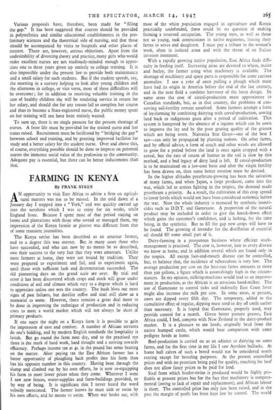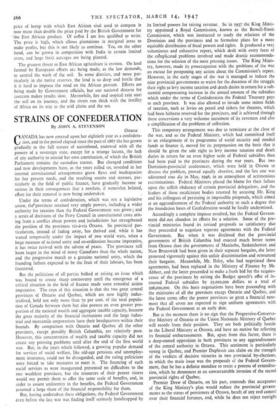FARMING IN KENYA
By FRANK SYKES
AN' opportunity to visit East Africa to advise a firm on agricul- tural matters was not to be missed. In the cold dawn of a January day I stepped into a "York," and was quickly carried up into the sunshine which I was to enjoy for six weeks, while England froze. Because I spent most of that period staying on farms and plantations with those who owned or managed them, my impression of the Kenya farmer or planter was different from that of some transient journalists.
The Kenya settler has been described as an amateur farmer, and to a degree this was correct. But in many cases those Who have succeeded, and who can now by no means be so described, owe their success to the very fact that they were amateurs. Unlike most farmers at home, they were not bound by tradition. They were prepared to experiment and fail, and to experiment again, until those with sufficient luck and determination succeeded. The old pioneering days on the grand scale are over. By trial and error it has been discovered which crops and stock will grow under conditions of soil and climate which vary to a degree which is hard to appreciate unless one sees the country. The bush blots out most signs of past failures, but derelict coffee and sisal still show as a memorial to some. However, there remains a great deal more to be done in improving the technique of production and in reducing costs to meet a world market which will not always be short of primary products.
If one stays the night on a Kenya farm it is possible to gain the impression of ease and comfort. A number of African servants do one's bidding, and by modern English standards the hospitality is lavish. But go round the farm next day, and to the practised eye there is the mark of hard work, hard thought and a striving towards efficiency. Perhaps income tax at 4s. in the pound has some bearing on the matter. After paying tax the East African fanner has a better opportunity of ploughing back profits into his farm than has his opposite number in this country. Having been through the slump and climbed out by his own efforts, he is now re-equipping his farm to meet lower prices when they come. Wherever I went I saw new fences, water-supplies and farm-buildings provided, or by way of being. It is significant that I never heard the word subsidy mentioned. The farmer knows he must sink or swim by his own efforts, and he means to swim. When war broke out, with most of the white population engaged in agriculture and Kenya practically undefended, there could be no question of making farming a reserved occupation. The young men, as well as those not so young, took commissions in native regiments, leaving their farms to wives and daughters. I must pay a tribute to the women's work, often in isolated areas and with the threat of an Italian invasion imminent.
With a rapidly growing native population, East Africa finds diffi- culty in feeding itself. Increasing areas are devoted to wheat, maize and barley, the farmer using what machinery is available. The shortage of machinery and spare parts is responsible for some curious anomalies. I saw a yoke of oxen pulling a plough which must have had its origin in America before the end of the last century, and in the next field a combine harvester of the latest design. In some areas the cost of cereal-production must approximate to Canadian standards, but, as in that country, the problems of con- serving soil-fertility remain unsolved. Some farmers attempt a form of ley:farming by combining dairying with cereal-production, sowing land back to indigenous grass after a period of cultivation. This system is hampered by the absence of a legume which can be sown to improve the ley and by the poor grazing quality of the grasses which are being sown. Naivasha Star Grass—one of the best I saw—can only be propagated by planting stolons. On other farms, and by official advice, a form of couch and other weeds are allowed to grow, for a period before the land is once again cropped with a cereal, but the rate of return of humus to the soil is slow by this method, and a bad legacy of dirty land is left. If cereal-production is to be maintained on a low-cost basis and after the virgin fertility has been drawn on, then some better rotation must be devised.
In the higher altitudes pyrethrum-growing has been the salvation of many farms, and when Japan, a large producer, came into the war, which led to armies fighting in the tropics, the demand made pyrethrum a priority. As a result, the cultivation of this crop spread to lower levels which would not have been considered economic before the war. Now the whole industry is menaced by synthetic insecti- cides such as D.D.T. and Gamexane. A proportion of the natural product may be included in order to give the knock-down effect which gains the customer's confidence, and is lacking, for the time being, in the synthetic. But to fill the gap new crops will have to be found. The growing of lavender for the distillation of essential oil should fill some small part of it.
Dairy-farming is a prosperous business where efficient stock- management is practised. The cow is, however, heir to every disease we know at home, and in addition several which are found only in the tropics. All except foot-and-mouth disease can be controlled, but, to balance that, the incidence of tuberculosis is very low. The average production per cow on the best-run farms amounts to more than soo gallons, a figure which is astonishingly high in the circum- stances. In my opinion, milking-machines would lead to an improve- ment in production, as the African is an atrocious hand-milker. The use of Gamexane to control ticks and indirectly East Coast fever might also increase the milk per cow. In some areas, at present, cows are dipped every fifth day. The temporary, added to the cumulative effect of regular, dipping must tend to dry off cattle earlier than necessary. It is hoped that Gamexane, properly used, may provide control for a month. Given better pasture grasses, East Africa could, I feel, compete with New Zealand in the dairy-product market. It is a pleasure to see herds, originally bred from the native humped cattle, which would bear comparison with some pedigree herds at home.
Beef-production is carried on as an adjunct to dairying on some farms, and for the first time in my life I saw Ayrshire bullocks. At home bull calves of such a breed would not be considered worth rearing except for breeding purposes. At the present controlled prices and with no premium being paid for quality, ranching for beef does not allow fancy prices to be paid for land.
Sisal from which binder-twine is produced would be highly pro- fitable at present prices but for the fact that machinery is tempera- mental (owing to lack of repair and replacement), and African labour is short. The controlled price has only just been raised, and in the past the margin of profit has been kept low by control. The world
price of hemp with which East African sisal used to compete is now more than double the price paid by the British Government for 'the East African product. Of coffee I am less qualified to write. The price is high, which allows plantations in marginal -areas to make profits, but this is not likely to continue. Tea, on the other hand, can be grown in competition with India in certain limited areas, and large fresh acreages are being planted.
The greatest threat to East African agriculture is erosion. On land farmed by Europeans efforts ar.:. being made, as the law demands, to control the wash of the soil. In some districts, and more par- ticularly in the native reserves, the land is so deep and fertile that it is hard to impress the need on the African peasant. Efforts are being made by Government officials, but our national distaste for coercion makes results slow. Meanwhile, fire and tropical rain start the soil on its journey, and the rivers run thick with the fertility of Africa on its way to the arid plains and the sea.



































 Previous page
Previous page